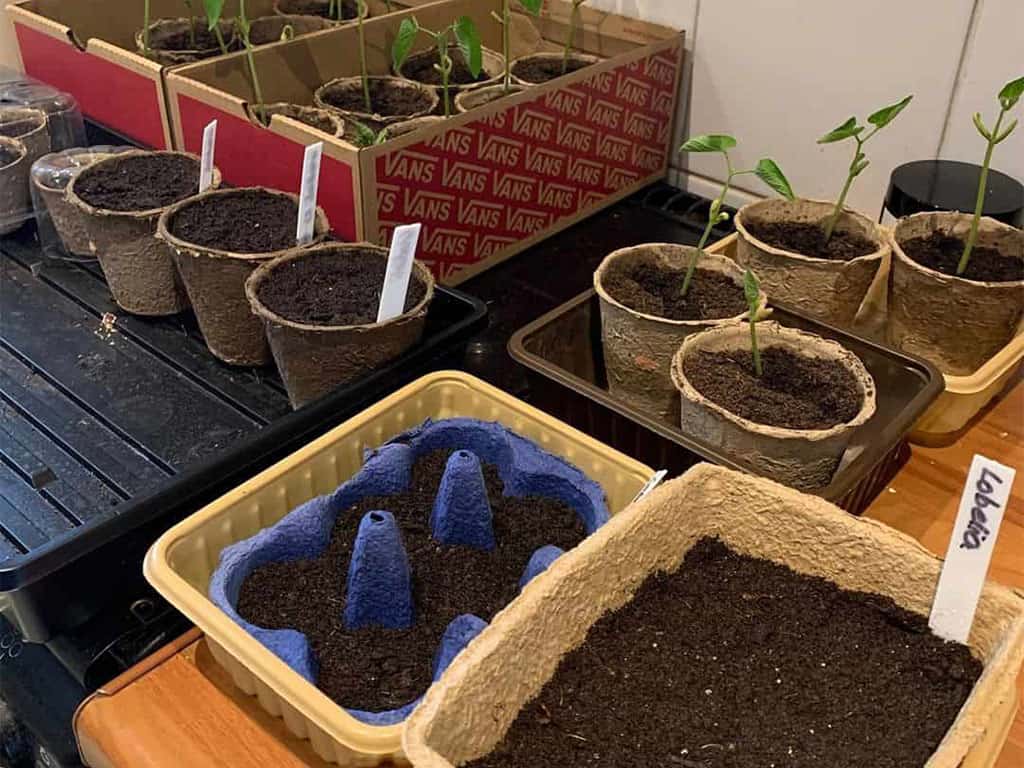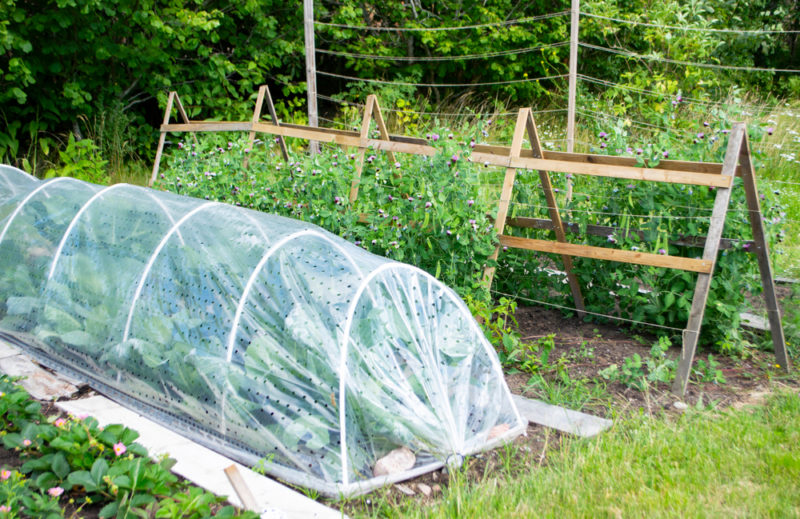You can grow plenty of crops in winter, even in an unheated greenhouse. To help you get started, we’ve put together a list of some of the easiest crops to grow in a greenhouse during the colder months.
We’re focusing on cold-hardy vegetables you can grow in a simple plastic or glass greenhouse. In a heated greenhouse, you can try growing just about any vegetable and tropical fruit, too.

Image credit: @deerparkcountryhouse
Winter Greenhouse Vegetable Ideas
So what to grow in a greenhouse in winter? Here’s how to get started with winter greenhouse growing.
1. Green up your winter greenhouse with some spinach

Image credit: @pairagardens
Spinach is a winter favourite for many gardeners because it’s easy to grow in an unheated greenhouse. Look for hardy varieties and sow them in autumn to help them to grow faster.
Don’t worry if temperatures drop. It may slow down their growth, but you should still have a rich crop. Spinach can survive temperatures below 5 degrees Celsius.
Good to know: Because of the colder temperatures and fewer hours of sunlight, plants in your greenhouse will grow more slowly in winter. Have a little patience with them.
2. Plant some kale

Try growing the impressive dino kale. Image credit: @growing_spaces
Another cold-hardy leafy green, kale is highly nutritious, packing awesome amounts of vitamins A, C, and K. Plant it in your greenhouse next to spinach, and you could be enjoying crunchy kale chips mid-winter.
The best part is that frosty temperatures can make kale taste sweeter. So you have no excuse not to plant it in your winter greenhouse.
Tip: Harvest only the leaves and the plant will continue to grow throughout winter.
3. Grow greenhouse seed potatoes in bags or containers

Image credit: @kathrynhawkinsfood
You don’t need much space to grow potatoes in your greenhouse because you won’t be planting them directly in the ground. Plant seed potatoes in containers, sacks, or plastic bags and keep them under shelter. You’ll have homegrown potatoes in time for the winter holidays.
Tip: Shop for cold-stored potato tubers at a specialist store to grow different varieties.
4. Sow some lettuce

Image credit: @lottiesplots1726
Growing lettuce in winter is easier than growing it in summer. That’s because the lower temperatures will prevent it from bolting. You can sow winter lettuce in an unheated greenhouse as late as November.
If you have time, start it earlier so you can plant it every two weeks or so. That way, you’ll be getting a continuous crop throughout the snowy months. With winter-planted lettuce, you can enjoy a crop in as little as 6 weeks.
Tip: Some of the best varieties of lettuce to grow in winter include cos, butterhead, winter purslane and lamb’s lettuce.
5. Add winter cabbage to your crops

Image credit: @sams_allotment_n_life
Winter cabbage seeds can germinate at temperatures as low as 4 degrees Celsius. Sow winter cabbage in late summer or early autumn. You can start the seedlings indoors before moving them to your greenhouse. This will protect them from strong sun, which can burn them.
You can harvest winter cabbage early in winter and then throughout spring if you sow it in weekly, successive crops.
Tip: You can refrigerate winter cabbage (without freezing it) for several months if you won’t be eating it all right away.
6. Rocket up your salads

Image credit: @greenthumbgertrude
Rocket can do well in the cool climate of your winter greenhouse. It’s true that it takes longer to grow than in spring. But it won’t bolt, and you’ll have a fresh and steady supply of leafy greens to add to your salads.
Most rocket varieties, including arugula and rucola, handle the cold well. Even if many seed catalogues list them as a summer crop, that shouldn’t stop you from growing them in your greenhouse during the colder months.
7. Reserve a sunny corner for parsley

Image credit: @chefpaulrifkin
Just 30 grams of chopped parsley can cover your daily vitamin A and K needs and supply half of the daily recommended dose of vitamin C. Add to that the fact that it’s a cold-hardy herb that keeps growing throughout the year, and that it doesn’t need much space either, and you have great reasons to add it to your greenhouse.
Harvest the leaves carefully, without cutting too much of the stalks. Careful picking will make it easier for your parsley plants to keep growing fresh leaves even in cooler temperatures.
Tip: Other herbs you can grow in your greenhouse over winter include coriander, chervil, and dill.
8. Make room for some sweet and crunchy carrots

Image credit: @circleorganic
Carrots are another crop that grow better in a winter greenhouse than in a summer one, which is often too hot for them. Sow seeds in autumn about 2 inches apart and you’ll be able to harvest a crop early in spring.
Keep the soil moist for the seedlings but avoid overwatering them. You may also have to thin them out if they grow too close together. Thin lightly and repeatedly, removing the weakest plants.
Good to know: Growing root vegetables like carrots in a colder environment can make them taste sweeter.
9. Plant pak choi as a companion to carrots

Image credit: @andyspassion_de
If there’s room for another leafy crop in your greenhouse, give pak choi a try. This type of Chinese cabbage is frost tolerant and grows in as little as 30 days, after which you can start plucking leaves.
Are you a patient gardener? You can wait for the plant to mature, which takes a little over two months. The whole plant makes for a tasty ingredient in oriental stir-fries and soups.
10. Grow Brussels sprouts over winter

Image credit: @pan_tasak
Brussels sprouts sown in late autumn take about 3 months to grow. If you still have space left in your greenhouse after planting other winter crops, you may want to sow some Brussels sprout seeds too.
By March next year, you’ll be able to enjoy them roasted, sauteed, in soups, or any other way you like them. Like with other cool-weather veggies, Brussels sprouts grown over winter taste better than those grown in the summer. Don’t trust us? Grow some and see for yourself.
11. Grow some (more) peas

Image credit: @brainstormacres
Shivery weather won’t bother your greenhouse peas, provided you plant them before the beginning of November. Choose a sunny spot where they will get as much winter sunlight as possible.
Snow peas and snap peas are two popular varieties you can grow over winter but you can try others too if you’ve tasted these already. One thing to remember is that some varieties can take twice as long as others to yield a harvest.
12. Overwinter some broad beans in greenhouse pots

Image credit: @cwtch.cottage
Broad bean seedlings do better in cooler weather, becoming stronger and more resistant to damage. The only problem you may face is winter wet, which can rot them if the soil doesn’t drain well.
If you’re not sure about the soil, you can plant them in tall pots or containers and keep these in your greenhouse over winter. Come spring, you’ll have an early crop of broad beans to enjoy or freeze for future use.
13. Don’t forget about alliums

Enjoy sweet shallots in the spring. Image credit; @mainegarlicgal
Onions, garlic, leeks, shallots and spring onions will all be happy to call your unheated greenhouse home during winter, provided you can spare them from excess moisture. Depending on the variety you choose to plant, you’ll be able to enjoy them as early as next spring or summer.
Greenhouse alliums may take their time growing, but they’re undemanding and won’t mind the cooler temperatures. You can even plant allium bulbs as late as December but planting them earlier makes them more resistant to the cold and they’ll grow bigger.
FAQs
Can you grow vegetables in a greenhouse during winter?
Yes, you can grow delicious winter vegetables in your greenhouse while it’s snowing outside, even if your greenhouse isn’t heated. Some crops do better in a winter greenhouse than in a sunny one, so it would be a pity to leave your greenhouse empty during the colder months.
Plant cold-hardy vegetables like spinach, lettuce, parsley, potatoes, and other leafy greens in autumn before the temperatures drop to give the plants time to become established. Avoid excessive humidity by ventilating your greenhouse on sunny days, and be careful not to overwater your plants or you may encourage winter rot.
What kind of vegetables can you grow in a greenhouse in the winter?

Image credit: @madarastella
For best results, choose hardy and undemanding winter vegetables like leafy greens, potatoes, cool-season herbs, alliums such as onions, and root vegetables like carrots. Some of the best crops for a winter greenhouse include spinach, lettuce, kale, winter cabbage, rocket, parsley, Brussels sprouts, and peas. These crops won’t mind the cold and will keep growing slowly and steadily during the cold season.
What can you grow in an unheated greenhouse in the winter?
Leafy greens like spinach, rocket, lettuce and kale are resistant to the cold and often taste better when grown in a cooler environment, even if they take more time to reach maturity. Parsley, dill, coriander, and other hardy herbs will also grow in an unheated greenhouse during the colder months. Potatoes are another good winter crop that you can plant in greenhouse containers. If you’re not in a hurry to harvest, you can sow carrots, peas, broad beans, garlic, onions, and Brussels sprouts to harvest next year.
What temperature is too cold for a greenhouse?

Image credit: @monica.cappelen
Frost-hardy vegetables like spinach, kale, rocket, leeks, winter lettuce, and peas can survive air temperatures below freezing. The cold weather won’t kill these plants, only slow their growth. Keeping your greenhouse free from frost at a temperature of at least 3 degrees Celsius will give you even more planting options. Bear in mind that during the winter, the temperature in an unheated greenhouse will be a few degrees higher than outdoors.
Read more: 11 easy vegetables to grow indoors in winter

Save this pin for later






